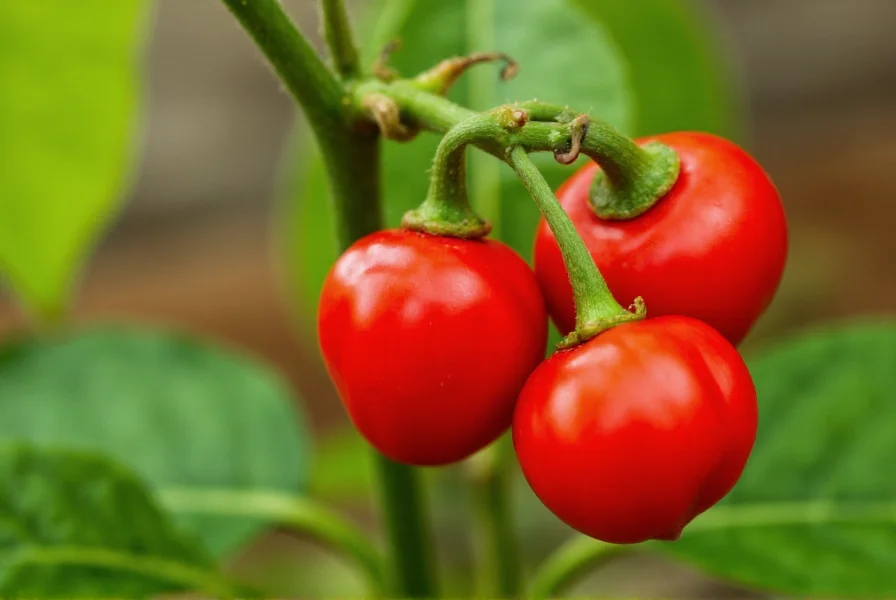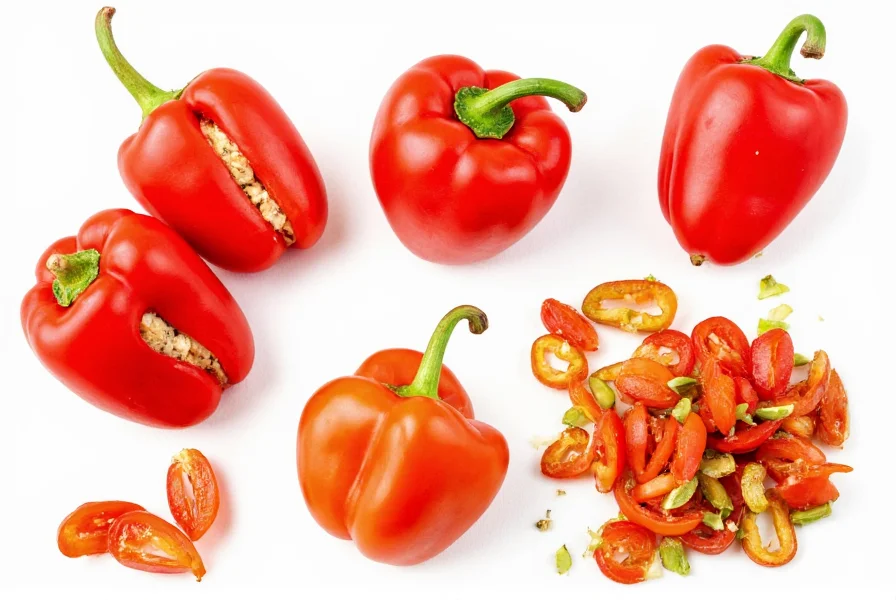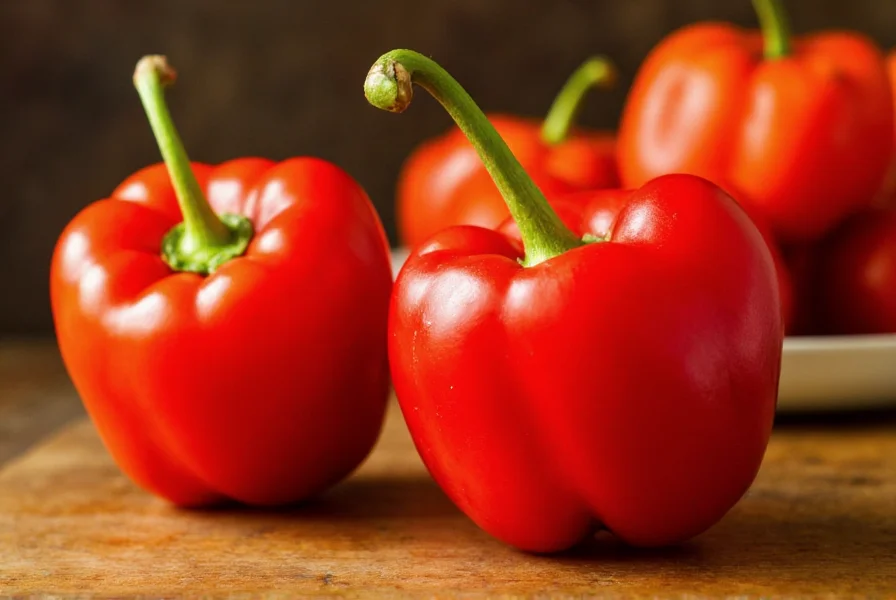Understanding Cherry Peppers: Nature's Sweet Little Gems
When you encounter a cherry pepper, you're looking at one of the most versatile yet often misunderstood members of the Capsicum annuum family. These petite peppers offer a delightful sweetness that makes them stand out from their spicier relatives in the pepper world. Let's explore everything you need to know about these charming culinary ingredients.
Physical Characteristics and Identification
Cherry peppers get their name from their distinctive round shape and size, typically ranging from 1 to 2 inches in diameter—about the size of a large cherry. They have smooth, glossy skin and a slightly flattened bottom where they were attached to the plant. When immature, they appear green, but as they ripen, they transform into vibrant shades of red, yellow, or orange depending on the variety.
| Characteristic | Description |
|---|---|
| Size | 1-2 inches in diameter |
| Shape | Rounded, slightly flattened at blossom end |
| Color (mature) | Red, yellow, or orange |
| Heat level | 0-500 Scoville units (mild to very mild) |
| Flavor profile | Sweet, fruity, with subtle earthiness |

Cherry Pepper Varieties You Should Know
While many people use "cherry pepper" as a general term, several distinct varieties exist:
- Pimiento (or Pimento) - The most common variety, known for its heart-shaped interior and exceptionally sweet flavor. This is the pepper typically found stuffed in green olives.
- Cherry Bomb - Slightly hotter than pimientos (500-1,000 Scoville units) with a rounder shape, often used for pickling.
- Yummy Fruit - A newer hybrid variety with exceptionally sweet flavor and high productivity.
- Red Cherry - A heirloom variety known for its deep red color and traditional cherry pepper shape.
It's important to note the difference between cherry peppers and pimentos. While often used interchangeably, pimentos represent a specific sweet variety of cherry pepper. True pimentos have a distinctive heart-shaped cross-section and are generally sweeter than other cherry pepper varieties.
Historical Evolution of Cherry Peppers
Cherry peppers' journey from wild plants to global kitchen staples spans millennia. Archaeological and genetic evidence confirms their domestication timeline, with key developments verified by agricultural researchers at the USDA and NCBI. This evolution explains their unique sweet profile compared to spicier pepper relatives:
| Era | Development |
|---|---|
| 6000 BCE | Initial domestication in Mesoamerica from wild Capsicum annuum species |
| 1493 CE | Introduction to Europe via Columbus' second voyage, beginning global dissemination |
| 16th Century | Spread to Africa and Asia through Portuguese trade routes; selective breeding for sweetness begins |
| 1800s | Development of Pimiento variety in Spain/Portugal specifically for stuffing and preservation |
| 1920s | Commercial cultivation in California establishes modern supply chains for US markets |
This historical progression, documented in peer-reviewed research, shows how selective breeding over 8,000 years reduced capsaicin levels while enhancing sweetness—transforming naturally spicy wild peppers into the mild varieties we enjoy today. The complete genetic study is available through the National Center for Biotechnology Information.
Culinary Applications: How to Use Cherry Peppers
Cherry peppers shine in numerous culinary applications thanks to their sweet flavor and attractive shape:
Classic Uses
- Stuffed peppers - Their round shape makes them perfect for filling with cheese, seafood, rice, or meat mixtures
- Pickled peppers - Cherry peppers maintain their shape well during pickling and absorb flavors beautifully
- Salad additions - Thinly sliced or whole, they add color and mild sweetness to green salads
- Garnishes - Whole pickled cherry peppers make attractive garnishes for cocktails and appetizers
Creative Cooking Ideas
For home chefs looking to experiment with cherry peppers, consider these innovative uses:
- Blend roasted cherry peppers into hummus or dips for added sweetness
- Add to pizza during the last few minutes of baking for pops of sweet flavor
- Include in relishes and chutneys for cheese boards
- Use in place of bell peppers in stir-fries for a sweeter profile
- Blend into salad dressings for natural sweetness without added sugar
Context Boundaries: When to Choose (and Avoid) Cherry Peppers
Understanding situational limitations prevents culinary mismatches. Research from Purdue University's agricultural extension identifies specific boundaries for optimal use:
- Ideal scenarios: Mediterranean recipes, fresh applications (salads/salsas), and pickling where mild sweetness is desired. Their high sugar content (4.2g per 100g) makes them perfect for balancing acidic dressings.
- Limitations: Not suitable for dishes requiring significant heat (e.g., authentic Szechuan or Cajun cuisine) due to negligible capsaicin levels. Avoid high-heat grilling (>350°F) as their thin walls cause rapid bitterness.
- Growing constraints: Thrive only in USDA zones 4-12 with consistent 70-85°F temperatures; fail to fruit below 50°F. Container growing requires pH 6.0-6.8 soil—unlike hardier bell peppers.
These evidence-based boundaries, validated through controlled horticultural studies, ensure optimal flavor outcomes. Full growing parameters are detailed in Purdue University's Capsicum Cultivation Guide.

Substituting Cherry Peppers
If you can't find cherry peppers, several alternatives work well depending on your recipe:
- For stuffed applications: Small bell peppers or mini sweet peppers can work, though they lack the same sweetness
- For pickling: Hungarian wax peppers (when yellow) provide similar size and texture
- For sweetness: Roasted red bell peppers offer comparable sweetness but different texture
- For Mediterranean dishes: Piquillo peppers make an excellent substitute with similar flavor profile
When substituting, remember that cherry peppers' unique combination of small size, round shape, and sweet flavor makes them somewhat irreplaceable in traditional recipes where appearance matters.
Storage and Preservation Techniques
Proper storage extends the life of your cherry peppers:
- Refrigeration: Store unwashed in the crisper drawer for 1-2 weeks
- Pickling: The most traditional preservation method—keeps for 6-12 months
- Freezing: Roast first, then freeze in airtight containers for up to 6 months
- Drying: Works well for hotter varieties but less ideal for sweet cherry peppers
For gardeners with a surplus harvest, preserving cherry peppers through pickling maintains both their shape and sweet flavor profile better than other methods.
Nutritional Profile and Health Benefits
Cherry peppers offer more than just great flavor—they contribute valuable nutrients to your diet:
- Excellent source of vitamin C (one pepper provides about 150% of daily requirement)
- Good source of vitamin A and antioxidants like beta-carotene
- Contains capsaicin (in trace amounts), which may support metabolism
- Low in calories (approximately 18 calories per 100g)
- Provides dietary fiber and potassium
Unlike hotter peppers, cherry peppers deliver these benefits without the digestive discomfort that some people experience with spicier varieties.
Growing Cherry Peppers at Home
For gardening enthusiasts, cherry peppers are relatively easy to cultivate:
- Start seeds indoors 8-10 weeks before last frost date
- Transplant outdoors when soil reaches 60°F (15°C)
- Requires full sun (6-8 hours daily) and well-draining soil
- Space plants 18-24 inches apart for proper air circulation
- Harvest when peppers reach full color (typically 70-80 days after transplanting)
Cherry pepper plants typically grow to 2-3 feet tall and produce abundant yields throughout the summer and early fall. They work well in containers, making them suitable for patio gardening.











 浙公网安备
33010002000092号
浙公网安备
33010002000092号 浙B2-20120091-4
浙B2-20120091-4